Your Cart is Empty
Menu
-
- Home
- New Arrivals
- Brands
- .Urukust
- ai amu indigo products
- Akashiya
- APICA
- Artisan and Artist
- Ateliers Penelope
- Ateliers Phileas
- Carta Pura
- Cozyca products
- CROOTS England
- Daruma Factory
- Diamine Inks
- e+m
- Echizen Lacquerware
- Esmie
- Esterbrook Pens
- Exacompta Exatime
- Furukawa Shiko
- Herbin
- i ro se
- Jhands
- Kakimori
- KAPPADO
- Kaweco
- Kleid Stationery
- Kobeha Graphilo
- Kochi
- KOH-I-NOOR HARDTMUTH
- Kokuyo
- KOMO Handsome Linen
- Koyomi Seikatsu
- KUNISAWA
- Kyoku Haku
- Lamy
- Marineday
- Maruai Paper
- Masuya Monokaki Notebooks
- Merchant & Mills
- MD Paper Products
- Midori
- Musubi Furoshiki
- MWC
- Nagao Orifu Indigo Products
- Nanala Design
- Nomado Store
- O'CHECK DESIGN GRAPHICS
- Palomino Blackwing
- PAL PLANNER
- Papier Platz
- Peg and Awl
- Penco
- PICUS
- Platinum
- Rhodia
- Roterfaden
- Round Top
- Sailor Pen
- Sakae Technical Paper
- Sanby
- Shogado
- Smith's Leather Balm
- Sonnenleder
- Suatelier
- Taylor's Eye Witness
- TEN Stationery
- Tombow
- Tomoe River
- Tools To Live By
- Traveler's Company
- Tsubame Note
- TWSBI
- un.quatre atelier
- Uni Mitsubishi Pencil Company
- VAU
- Yamamoto Paper
- Ystudio
- Products
- By Price
- Blog
- Outlet
-
- About Us
- Contact
- Shipping
- Terms & Conditions
- Returns
- FAQ
- Login

Brands
- i ro se
- Jhands
- Kakimori
- KAPPADO
- Kaweco
- Kleid Stationery
- Kobeha Graphilo
- Kochi
- KOH-I-NOOR HARDTMUTH
- Kokuyo
- KOMO Handsome Linen
- Koyomi Seikatsu
- KUNISAWA
- Kyoku Haku
- Lamy
- Marineday
- Maruai Paper
- Masuya Monokaki Notebooks
- MD Paper Products
- Merchant & Mills
- Midori
- Military Watch Company (MWC)
- Musubi Furoshiki
- Nagao Orifu Indigo Products
- Nanala Design
- Nomado Store
- O'CHECK DESIGN GRAPHICS
- Palomino Blackwing
- PAL PLANNER
- Papier Platz
- Peg and Awl
- Penco
- PICUS
- Platinum
- Rhodia
- Roterfaden
- Round Top
- Sailor Pen
- Sakae Technical Paper
- Sanby
- Shogado
- Smith's Leather Balm
- Sonnenleder
- Suatelier
- Taylor's Eye Witness
- TEN Stationery
- The Superior Labor
- Tombow
- Tomoe River
- Tools To Live By
- Traveler's Company Japan
- Tsubame Note
- TWSBI
- i ro se
- Jhands
- Kakimori
- KAPPADO
- Kaweco
- Kleid Stationery
- Kobeha Graphilo
- Kochi
- KOH-I-NOOR HARDTMUTH
- Kokuyo
- KOMO Handsome Linen
- Koyomi Seikatsu
- KUNISAWA
- Kyoku Haku
- Lamy
- Marineday
- Maruai Paper
- Masuya Monokaki Notebooks
- MD Paper Products
- Merchant & Mills
- Midori
- Military Watch Company (MWC)
- Musubi Furoshiki
- Nagao Orifu Indigo Products
- Nanala Design
- Nomado Store
- O'CHECK DESIGN GRAPHICS
- Palomino Blackwing
- PAL PLANNER
- Papier Platz
- Peg and Awl
- Penco
- PICUS
- Platinum
- Rhodia
- Roterfaden
- Round Top
- Sailor Pen
- Sakae Technical Paper
- Sanby
- Shogado
- Smith's Leather Balm
- Sonnenleder
- Suatelier
- Taylor's Eye Witness
- TEN Stationery
- The Superior Labor
- Tombow
- Tomoe River
- Tools To Live By
- Traveler's Company Japan
- Tsubame Note
- TWSBI
Superior Labor x Nomado Store Sashiko Bag: Traditional Okayama!
January 03, 2020 4 min read

This was November 2018, we’d just arrived at Nap Village, Superior Labor’s compound located 50 minutes from central Okayama in the mountains, and were sitting comfortably in their store sipping their own brand of coffee.
TSL owner Kawai-san pointed at my jacket and exclaimed “that’s Japanese sashiko cloth!” I was indeed wearing a new indigo dyed jacket bought at Momotaro, my favourite Okayama clothing brand. The jacket is vintage workwear-inspired (shawl collar, etc.) and made from a lovely cotton sashiko material dyed a deep natural indigo and woven on a “dobby loom” (see below).
We agreed that we both loved the material and the fact that is was so quintessentially Japanese. Our meetings with TSL tend to cover a lot of topics, but are always very creative. The conversation evolved rapidly into a discussion on how we could use the material to make a unique bag together.
13 months later, we are proud to announce the launch of the Superior Labor x Nomado Store Sashiko Bag! TSL worked hard on the design and spent a considerable amount of time sourcing the finest sashiko material.
The body of the bag is made of a deep blue indigo “dobby” type woven sashiko material (see below for details) and is lined in navy blue canvas. We deliberately chose to keep the material as supple as possible (no rigid lining), to avoid it being too bulky.
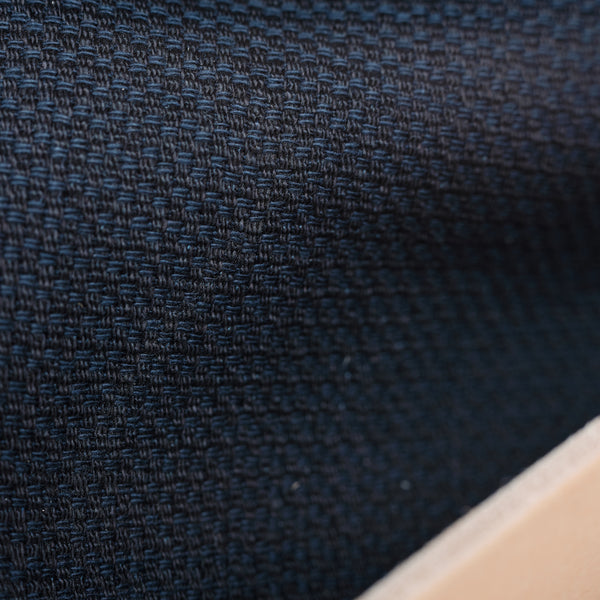
We chose TSL’s classic Japanese natural leather for the fittings, including handles, leather corners on the bottom to reduce wear, a shoulder strap with shoulder pad, brass “lucky turtle” charm and a generously sized zipped pocket on the rear (easily fits a regular Traveler’s Notebook). The design is classic The Superior Labor and the bag is handmade in Japan in small production runs.
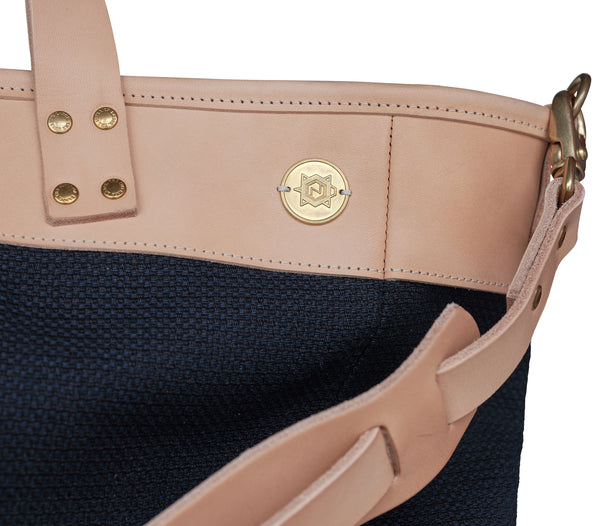
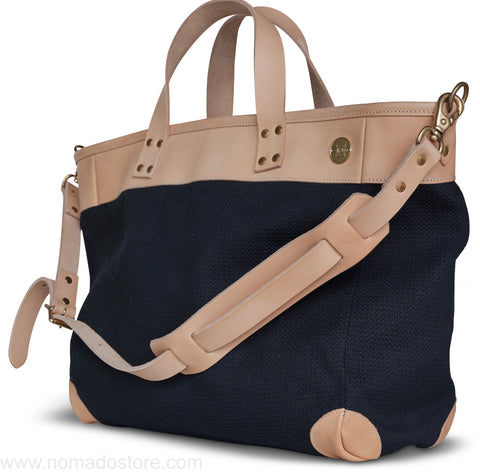
Because of the organic materials, this bag’s appearance will change with use (getting more beautiful in our opinion), the sashiko cloth will fade in places and look even more gorgeous, the leather will darken with exposure to sunlight and may even show some indigo colour transfer.
The Japanese love to see patina on objects they use daily, including textiles and leather and this is also why we decided to move forward with this project. When you use your Sashiko Bag, you will be savouring a key element of traditional Japanese culture which will last you a long time and just keep getting better.
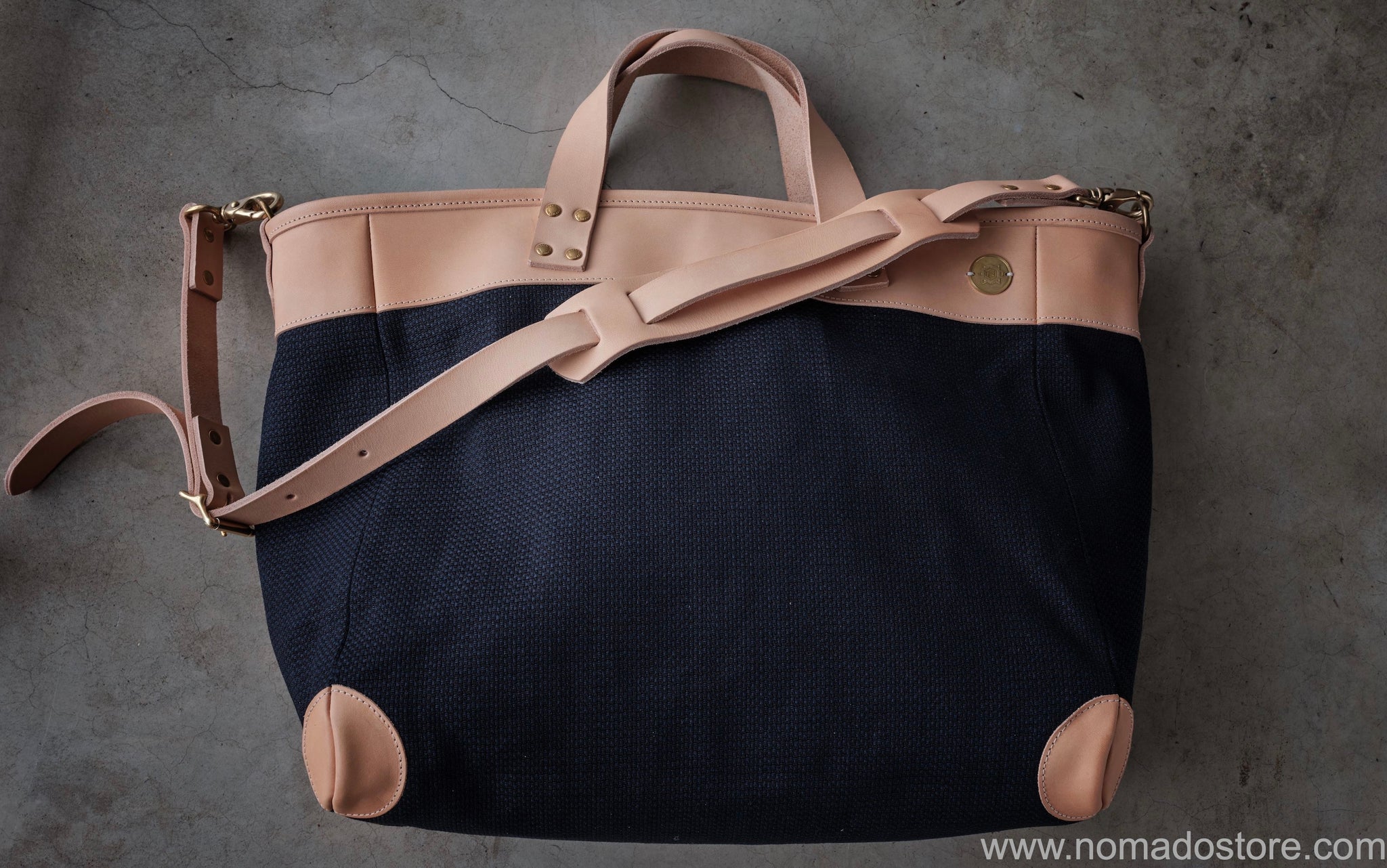
Important note: the indigo dye used for the sashiko cloth can cause colour transfer by friction on lighter materials, please read the detailed description below.
About the indigo dyed sashiko material
As mentioned above, the sashiko material is very hard to source and therefore also expensive. It feels completely different from regular canvas, being soft but with a great geometric texture (thanks to the dobby weave)
Indigo dye has seen widespread use in Japan since the Edo era and is still a key local industry in the Okayama area, especially in Kojima. Some of the best indigo dyed denim jeans are made there and fetch high prices (200-400 USD is considered “normal” at this quality level).
Indigo used to be a typical colour for the lower social classes, while the ruling classes were allowed to wear bright colours. This natural plant-based dye also has antibacterial and dirt repelling qualities. Samurai warriors would wear indigo dyed garments as a way to protect their bodies and wounds from infection.
Much of the indigo dye used nowadays is synthetic, but it is still possible to find the genuine article in Okayama. Unlike most dyes, natural indigo does not form a chemical bond with the cotton fabric, but a physical one, bonding molecularly to the fabric. Indigo cannot dissolve in water. When the indigo molecules bond to the fabric, the dye forms layers, which makes it very impervious to sunlight, but it will fade with friction and the colour may transfer to other materials by rubbing.
Sashiko (刺し子, "little stabs") is a form of geometric decorative reinforcement stitching from Japan that started out of practical need during the Edo era (1615-1868). Traditionally used to reinforce points of wear or to repair tears, making the piece, this running stitch technique is often used for purely decorative purposes and often on indigo blue cloth.
By the Meiji era (1868-1912) sashiko had been established enough that it had evolved into winter work in northern farming communities, when it was too cold to work outside.
Dobby cloth is a type of woven fabric known for having small geometric patterns. It is also known for being very textured compared with some weaves. It is made on a special machine known as a dobby loom.
A dobby loom is a type of floor loom that controls all the warp threads using a device called a dobby. The word dobby is a corruption of "draw boy," which refers to the weaver's helpers who used to control the warp thread by pulling on draw threads. Dobby looms first appeared around 1843.
You will find the Sashiko Bag page here.
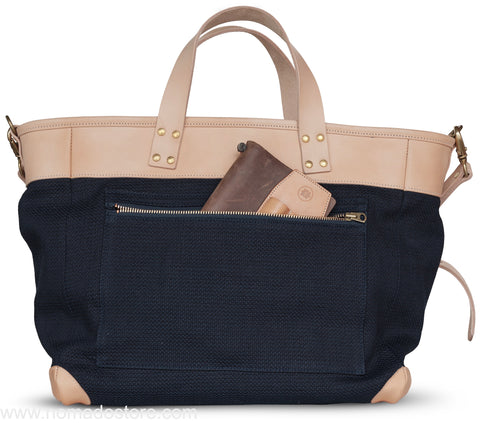
Subscribe
Sign up to get the latest on sales, new releases and more …

Newsletter
GET A 5% DISCOUNT OFF YOUR NEXT ORDER!
Keep informed of new products & exclusive promotions.
We respect your privacy.
